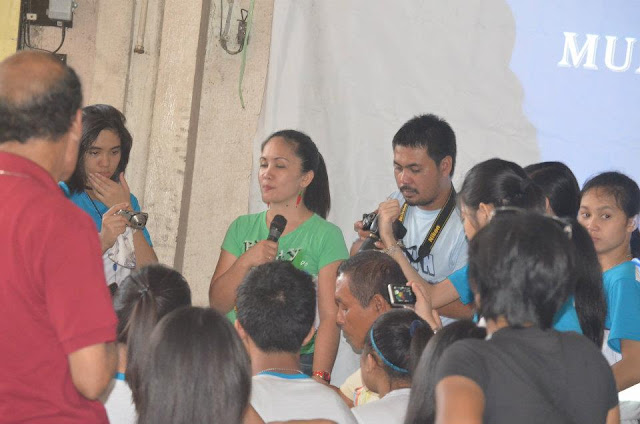Ibaan is not just a municipality. It is a place where rich diversity of traditions and culture continue to reside in the hearts of every Ibaeno. From 1832 since its establishment up to present time, the town never fails to look back to its humble beginnings, the same way how its people remember the simple yet steadfast ways of living that provided a colossal impact to its modest socio-economic development. It is at this tenet that Kulambuan Festival is being celebrated in the Municipality for its people to remain attached and for the young generations to understand the things that shaped the town itself.
 |
| Ms. Alyza Soriano with her two escorts. |
 | |
| Ms. Michelle mentoring Ms. Soriano. |
Watching the Kulambo Dance routines, one will evidently see Ibaan’s trademark that made them popular. The first part will show “paghahabi”, a traditional way of hand-weaving blankets and other clothing materials. But more importantly, of white soft cotton mosquito net that has been sold all over the archipelago and undeniably put Ibaan at the pedestal of the same industry. Such is being followed by steps depicting processes of harvesting sugarcane which is the primary driving force that pushed economy between 1960 and 1970, up to present time. Alas, Ibaan “maglalako” will not be missed as well. With “bilao” full of Ibaan’s native and famous delicacy “tamales” , together with “basta” overflowing with different items, specifically with our kulambo, our Ibaan “maglalako” was able to reach the four corners of the country which made them popular and as one of the most industrious among Batanguenos.
 |
| Mrs. Perez in her pagbati form. |
The Relationship
Despite the rigidness of the practice and the ensuing pressure from the competition itself, the working relationship of dancers, organizers, choreographers, and mentors remains calm as if everyone is just having a great doze of fun in the process. Watching them from distance, the best part of the practice can be seen on how Mrs. Michelle Ebora treat her dancers. Obviously, there exists a sweet bond between them, which of course is very important in any working activity. It's good thing to know there are teachers who know how to stoop down to the level of their students and still be one of them despite the differences on community status. In such, respect is given freely. Needless to say, dancer-students render their loyalty and dedication to the practice not because they fear of being reprimanded, but because they respect each other and their teachers. And street dance competition practice is not an exception.
 |
| Crisp laughter in students' company. |
Others may have been slashing their tongues against the back of those who have been sweating hard to make things possible for the street dance competition. With those photos that have been posted, hopefully they'll tie their tongue deep down their throat. And may they speak on how to make things better, instead of burying everyone alive six-feet under.
Let everything flow like a professional-working-relationship and be part of putting Ibaan's pride at the pedestal. Calaca, here comes Ibaan!
More photos.
More photos.
More photos.
More photos.


















































